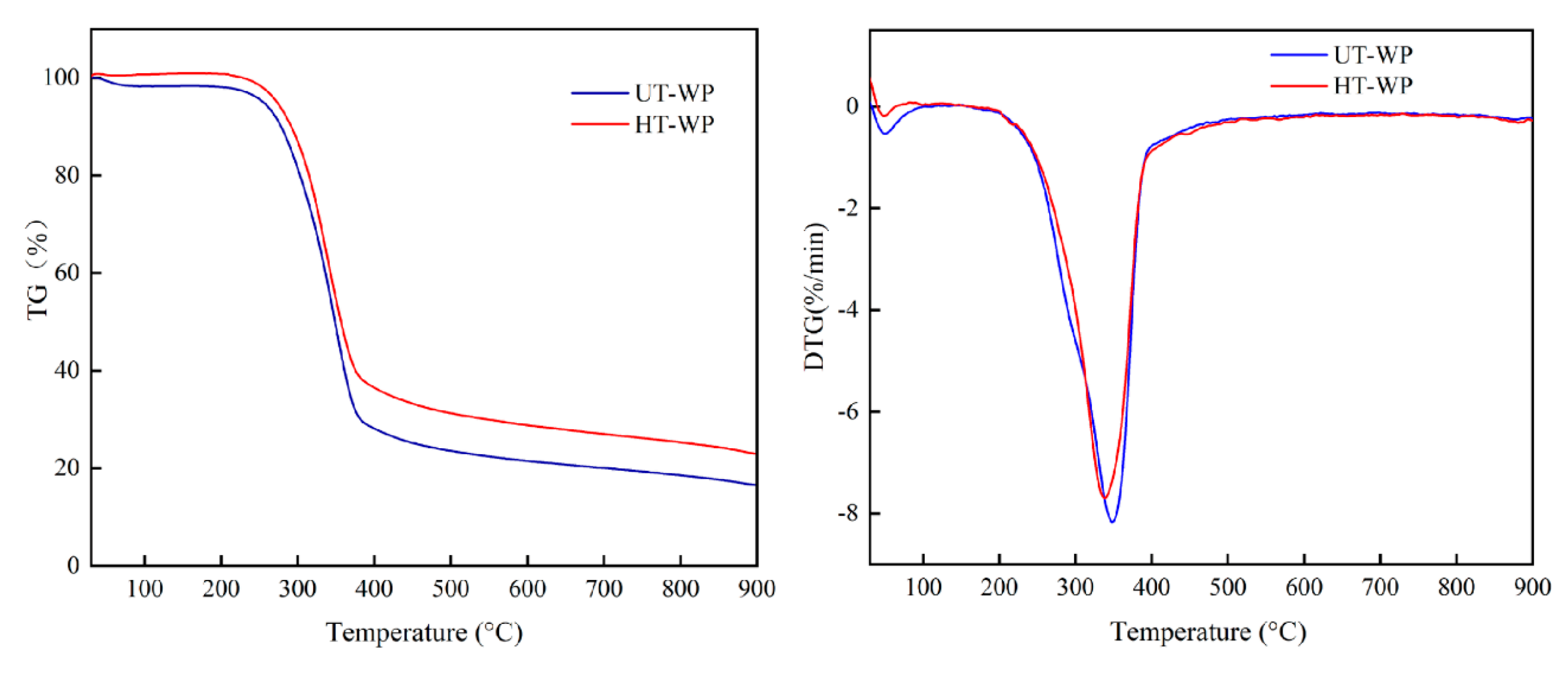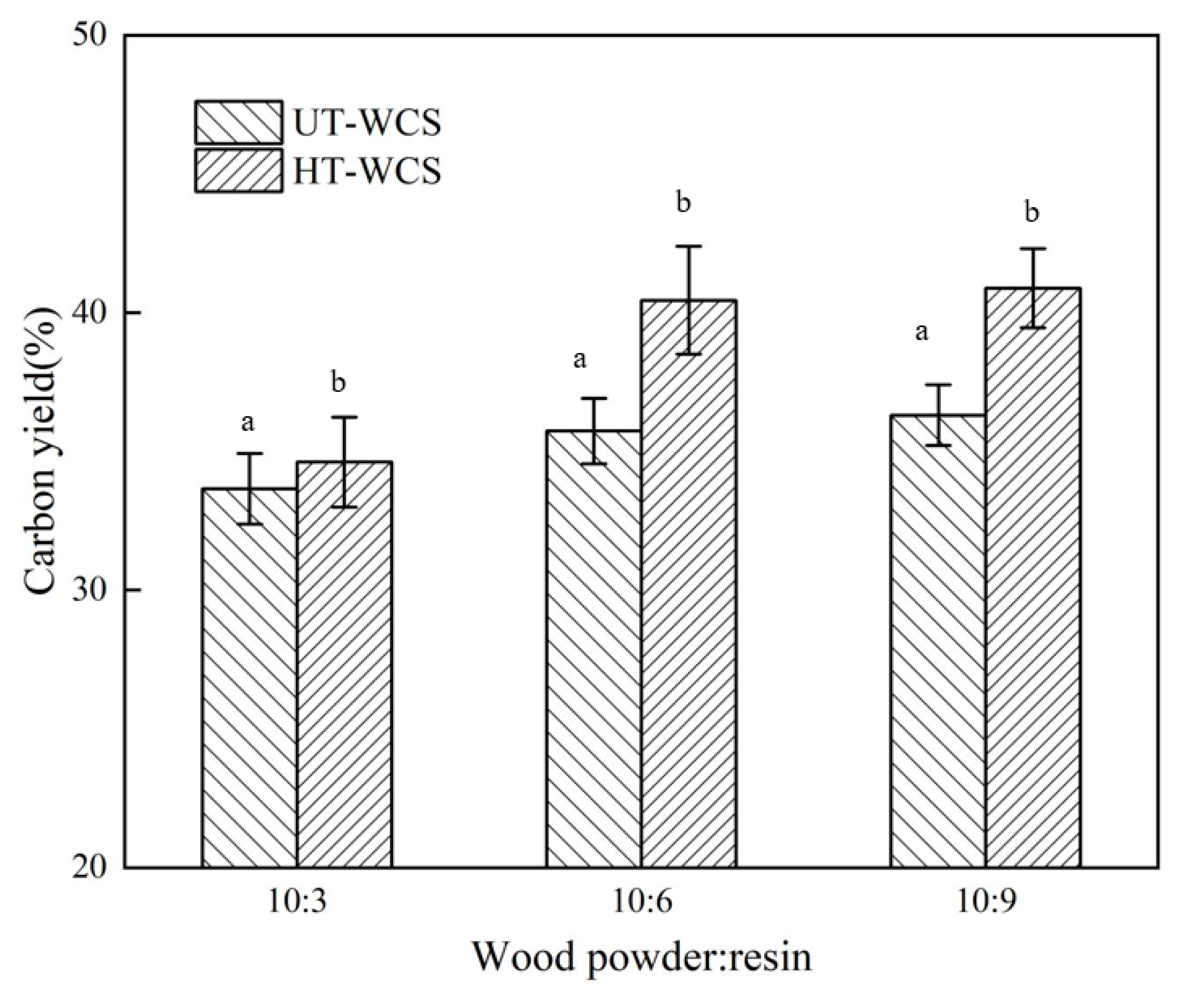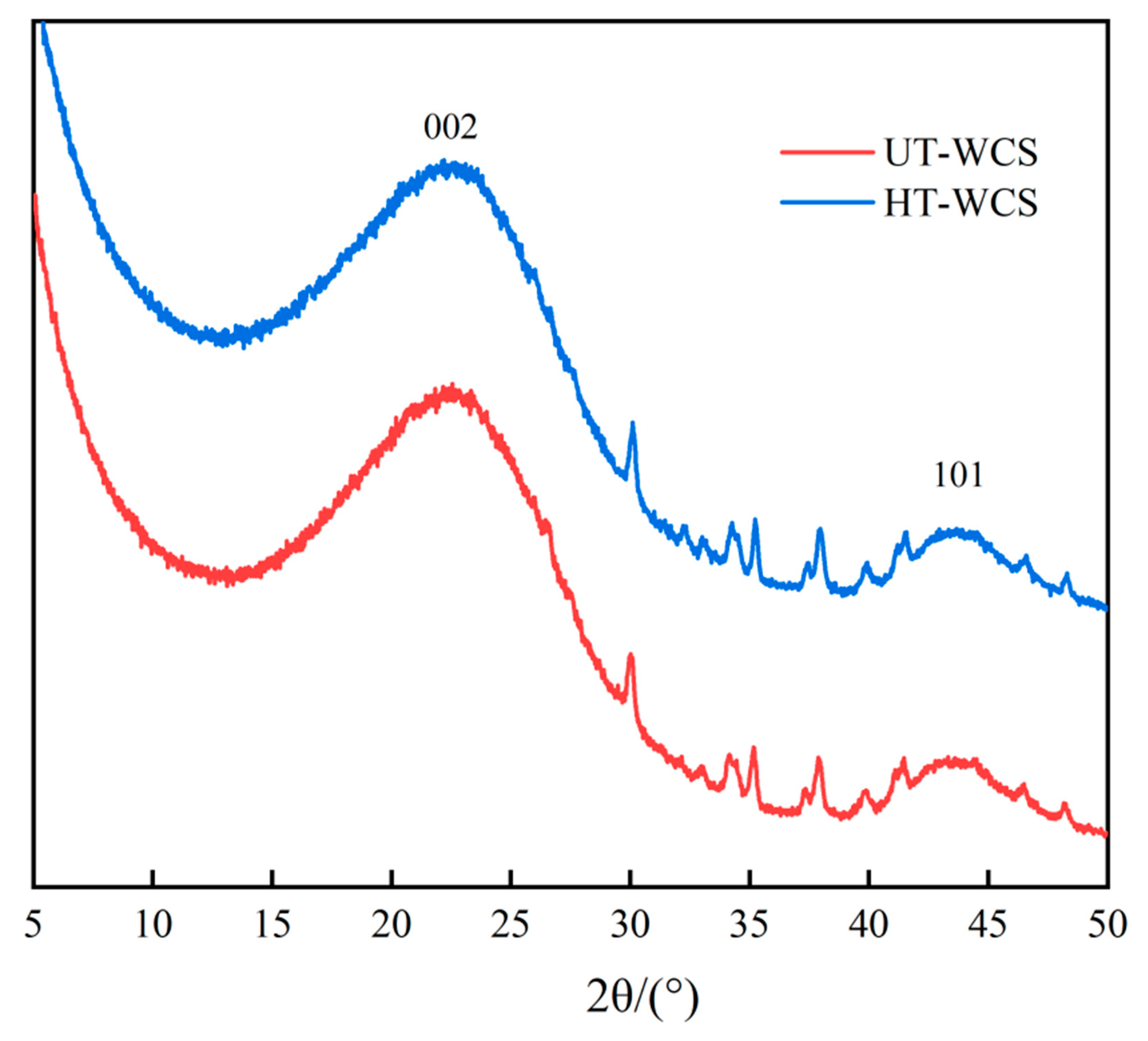Properties of Wood Ceramics Prepared from Thermo-Modified Poplar
Abstract
:1. Introduction
2. Materials and Methods
2.1. Sample Preparation
2.2. Manufacturing of WCS
2.3. Characterization of WCS
2.4. Statistical Analysis
3. Results and Discussion
3.1. Pyrolysis of Wood Powder
3.2. Properties of WCS
3.2.1. The Carbon Yield and Volume Shrinkage of WCS
3.2.2. Elemental Analysis of WCS
3.3. SEM Micrographs of WCS
3.4. FTIR Analysis
3.5. XRD Analysis
4. Conclusions
- With the increase in resin content, the carbon yield of WCS increased, and the volume shrinkage decreased. Considering the resource cost, 10:6 is the optimum proportion for preparing WCS. At the same ratio of wood powder/phenolic resins of 10:6 and carbonization temperature, the carbon yield of HT-WCS was 40.45% and of UT-WCS was 35.74%.
- The WCS has an interconnected porous network microstructure composed of amorphous carbon and glass carbon. At the same pyrolysis temperature, the microstructure of HT-WCS is more rigid and homogeneous. This indicates that the thermos-modified wood significantly helps to increase the performance of phenolic resin to mix wood powders, and leads to construct a more uniform porous microstructure, strengthening the bonding between the two types of carbon.
- There is typical non-graphitizable carbon-containing C = C bonds, C-O-C bonds and C–H structure. HT-WCS and UT-WCS have analogous chemical structures. For UT-WCS, the absorption peak of stretching C-O in the aromatic structure connected with the alkyl group is stronger than that of HT-WCS.
- The XRD patterns indicated that WCS contains amorphous carbon, turbine structure and graphite. The intensity and position of diffraction peaks in the pattern were almost similar with different materials, which indicate that the effect of different wood powders on the XRD pattern of WCS is minimal.
Author Contributions
Funding
Conflicts of Interest
References
- Okabe, T.; Saito, K.; Hokkirigawa, K. New porous carbon materials, Woodceramics: Development and fundamental properties. J. Porous Mater. 1996, 2, 207–213. [Google Scholar] [CrossRef]
- Wu, W.T.; Tan, F.L.; Xu, F. Preparation and Characteristic of Composites with Wheat Straw Woodceramic/Attapulgite. Appl. Mech. Mater. 2013, 330, 126–130. [Google Scholar] [CrossRef]
- Ramirez-Rico, J.; Martínez-Fernandez, J.; Singh, M. Biomorphic ceramics from wood-derived precursors. Int. Mater. Rev. 2017, 62, 465–485. [Google Scholar] [CrossRef] [Green Version]
- Singh, M. Environmentally conscious ceramics (ecoceramics) from natural wood precursors. Curr. Opin. Solid State Mater. Sci. 2003, 7, 247–254. [Google Scholar] [CrossRef]
- Qian, J.; Jin, Z.; Wang, J. Structure and basic properties of woodceramics made from phenolic resin–basswood powder composite. Mater. Sci. Eng. A 2004, 368, 71–79. [Google Scholar] [CrossRef]
- Mizutani, M.; Takase, H.; Adachi, N.; Ota, T.; Daimon, K.; Hikichi, Y. Porous ceramics prepared by mimicking silicified wood. Sci. Technol. Adv. Mater. 2005, 6, 76–83. [Google Scholar] [CrossRef] [Green Version]
- Jones, D.; Sandberg, D.; Goli, G.; Todaro, L. Wood Modification in Europe: Processes, Products, Applications; GESAAF—University of Florence: Florence, Italy, 2018; p. 41. [Google Scholar]
- Bal, B.C.; Bektaş, I. The Effects of Heat Treatment on Some Mechanical Properties of Juvenile Wood and Mature Wood ofEucalyptus grandis. Dry. Technol. 2013, 31, 479–485. [Google Scholar] [CrossRef]
- Chung, H.; Park, Y.; Yang, S.-Y.; Kim, H.; Han, Y.; Chang, Y.-S.; Yeo, H. Effect of heat treatment temperature and time on sound absorption coefficient of Larix kaempferi wood. J. Wood Sci. 2017, 63, 575–579. [Google Scholar] [CrossRef]
- Santos, J.A. Mechanical behaviour of Eucalyptus wood modified by heat. Wood Sci. Technol. 2000, 34, 39–43. [Google Scholar] [CrossRef]
- Yildiz, S.; Gezer, E.D.; Yildiz, U.C. Mechanical and chemical behavior of spruce wood modified by heat. Build. Environ. 2006, 41, 1762–1766. [Google Scholar] [CrossRef]
- Klingner, R.; Sell, J.; Zimmermann, T.; Herzog, A.; Vogt, U.; Graule, T.; Thurner, P.; Beckmann, F.; Müller, B. Wood-Derived Porous Ceramics via Infiltration of SiO2-Sol and Carbothermal Reduction. Holzforschung 2003, 57, 440–446. [Google Scholar] [CrossRef]
- Lin, Y.; Shen, Y.C.; Liu, H.Z.; Li, Y.J. Study of Physical-mechanical Properties of Bamboos through High Temperature Heat Treatment. For. Mach. Woodwork. Equip. 2012, 40, 22–24. [Google Scholar]
- Qian, J.-M.; Wang, J.-P.; Qiao, G.-J.; Jin, Z.-H. Preparation of porous SiC ceramic with a woodlike microstructure by sol-gel and carbothermal reduction processing. J. Eur. Ceram. Soc. 2004, 24, 3251–3259. [Google Scholar] [CrossRef]
- Shi, J.Y.; She, Y.; Wang, X.J. Study on modified phenolic resin bonded high moisture content veneer. J. Jilin Forest. Univ. 1997, 1, 17–21. [Google Scholar]
- Unsal, O.; Korkut, S.; Atik, C. The effect of heat treatment on some properties and colour in eucalyptus (Eucalyptus camaldulensis dehn.) wood. Maderas. Cienc. Technol. 2003, 5, 145–152. [Google Scholar] [CrossRef]
- Mitsui, K.; Takada, H.; Sugiyama, M.; Hasegawa, R. Changes in the Properties of Light-Irradiated Wood with Heat Treatment. Part 1. Effect of Treatment Conditions on the Change in Color. Holzforschung 2001, 55, 601–605. [Google Scholar] [CrossRef]
- Lekounougou, S.; Petrissans, M.; Jacquot, J.-P.; Gelhaye, E.; Gérardin, P. Effect of heat treatment on extracellular enzymatic activities involved in beech wood degradation by Trametes versicolor. Wood Sci. Technol. 2008, 43, 331–341. [Google Scholar] [CrossRef]
- Kocaefe, D.; Poncsak, S.; Tang, J.; Bouazara, M. Effect of heat treatment on the mechanical properties of North American jack pine: Thermogravimetric study. J. Mater. Sci. 2010, 45, 681–687. [Google Scholar] [CrossRef]
- Chaouch, M.; Pétrissans, M.; Petrissans, A.; Gerardin, P. Use of wood elemental composition to predict heat treatment intensity and decay resistance of different softwood and hardwood species. Polym. Degrad. Stab. 2010, 95, 2255–2259. [Google Scholar] [CrossRef]
- Bourgois, J.; Bartholin, M.-C.; Guyonnet, R. Thermal treatment of wood: Analysis of the obtained product. Wood Sci. Technol. 1989, 23, 303–310. [Google Scholar] [CrossRef]
- Dong, H.; Bahmani, M.; Rahimi, S.; Humar, M. Influence of Copper and Biopolymer/Saqez Resin on the Properties of Poplar Wood. Forests 2020, 11, 667. [Google Scholar] [CrossRef]
- Gao, J.M.; Meng, L.X.; Qi, J.K.; Ma, T.; Yan, Z.L.; Zhou, Z.L. Research on Silicon Carbide Woodceramics from Poplar Fiber. Rare Met. Mater. Eng. 2011, 40, 223–226. [Google Scholar]
- Mar’yandyshev, P.A.; Chernov, A.A.; Lyubov, V.K. Analysis of thermogravimetric data for different forms of wood. Solid Fuel Chem. 2015, 49, 117–122. [Google Scholar] [CrossRef]
- Qu, T.; Guo, W.; Shen, L.; Xiao, J.; Zhao, K. Experimental Study of Biomass Pyrolysis Based on Three Major Components: Hemicellulose, Cellulose, and Lignin. Ind. Eng. Chem. Res. 2011, 50, 10424–10433. [Google Scholar] [CrossRef]
- Zaman, A.; Alén, R.; Kotilainen, R. Thermal behavior of Scots pine (Pinus sylvestris) and silver birch (Betula pendula) at 200–230 °C. Wood Fiber Sci. 2000, 32, 138–143. [Google Scholar]
- Runkel, R.O.H.; Wilke, K.D. Zur Kenntnis des thermoplastischen Verhaltens von Holz. Eur. J. Wood Wood Prod. 1951, 9, 260–270. [Google Scholar] [CrossRef]
- Kollmann, F.; Fengel, D. Änderungen der chemischen Zusammensetzung von Holz durch thermische Behandlung. Eur. J. Wood Wood Prod. 1965, 23, 461. [Google Scholar] [CrossRef]
- Liu, G.; Song, H.; Wu, J. Thermogravimetric study and kinetic analysis of dried industrial sludge pyrolysis. Waste Manag. 2015, 41, 128–133. [Google Scholar] [CrossRef]
- Hosoya, T.; Kawamoto, H.; Saka, S. Cellulose–hemicellulose and cellulose–lignin interactions in wood pyrolysis at gasification temperature. J. Anal. Appl. Pyrolysis 2007, 80, 118–125. [Google Scholar] [CrossRef]
- Islamova, S.I.; Khamatgalimov, A. Thermogravimetric and kinetic analyses of the thermal decomposition of fuel wood. Solid Fuel Chem. 2017, 51, 83–87. [Google Scholar] [CrossRef]
- Yeo, J.Y.; Chin, B.L.F.; Tan, J.K.; Loh, Y.S. Comparative studies on the pyrolysis of cellulose, hemicellulose, and lignin based on combined kinetics. J. Energy Inst. 2019, 92, 27–37. [Google Scholar] [CrossRef]
- Zhao, S.; Liu, M.; Zhao, L.; Zhu, L. Influence of Interactions among Three Biomass Components on the Pyrolysis Behavior. Ind. Eng. Chem. Res. 2018, 57, 5241–5249. [Google Scholar] [CrossRef]
- Chen, T.; Li, L.; Zhao, R.; Wu, J. Pyrolysis kinetic analysis of the three pseudocomponents of biomass–cellulose, hemicellulose and lignin. J. Therm. Anal. Calorim. 2016, 128, 1825–1832. [Google Scholar] [CrossRef]
- Tjeerdsma, B.F.; Militz, H. Chemical changes in hydrothermal treated wood: FTIR analysis of combined hydrothermal and dry thermaly modified wood. Eur. J. Wood Wood Prod. 2005, 63, 102–111. [Google Scholar] [CrossRef]
- Windeisen, E.; Strobel, C.; Wegener, G. Chemical changes during the production of thermo-treated beech wood. Wood Sci. Technol. 2007, 41, 523–536. [Google Scholar] [CrossRef]
- Liu, Q.; Shen, D.K. Fractionated Pyrolysis of Biomass and its Components. Appl. Mech. Mater. 2014, 535, 734–737. [Google Scholar] [CrossRef]
- Suda, T.; Kondo, N.; Okabe, T.; Saito, K. Electrical Properties of Woodceramics. J. Porous Mater. 1999, 6, 255–258. [Google Scholar] [CrossRef]
- Fan, T.; Hirose, T.; Okabe, T.; Zhang, D. Surface Area Characteristics of Woodceramics. J. Porous Mater. 2001, 8, 211–217. [Google Scholar] [CrossRef]
- Pan, J.; Cheng, X.-N.; Yan, X.; Zhang, C. Preparation and hierarchical porous structure of biomorphic woodceramics from sugarcane bagasse. J. Eur. Ceram. Soc. 2013, 33, 575–581. [Google Scholar] [CrossRef]
- Oh, S.W.; Hirose, T.; Okabe, T. Manufacturing Characteristics of Wood ceramics from Thinned Small Logs (I)—Resin Impregnation Rate and Bending Strength. J. Korean Wood Sci. Technol. 2000, 28, 56–60. [Google Scholar]
- Popescu, M.-C.; Froidevaux, J.; Navi, P.; Popescu, C.-M. Structural modifications of Tilia cordata wood during heat treatment investigated by FT-IR and 2D IR correlation spectroscopy. J. Mol. Struct. 2013, 1033, 176–186. [Google Scholar] [CrossRef]
- Kercher, A.; Nagle, D.C. Evaluation of carbonized medium-density fiberboard for electrical applications. Carbon 2002, 40, 1321–1330. [Google Scholar] [CrossRef]
- Onodera, A.; Terashima, K.; Urushihara, T.; Suito, K.; Sumiya, H.; Satoh, S. High-pressure synthesis of diamond from phenolic resin. J. Mater. Sci. 1997, 32, 4309–4318. [Google Scholar] [CrossRef]
- Tzeng, S.-S.; Chr, Y.-G. Evolution of microstructure and properties of phenolic resin-based carbon/carbon composites during pyrolysis. Mater. Chem. Phys. 2002, 73, 162–169. [Google Scholar] [CrossRef]







| Samples | C (wt.%) | H (wt.%) | O (wt.%) | N (wt.%) |
|---|---|---|---|---|
| UT-WP | 45.59 | 7.5 | 46.9 | 0.01 |
| UT-WCS | 70.1 | 0.89 | 28.17 | 0.84 |
| HT-WP | 48.95 | 7.3 | 43.51 | 0.24 |
| HT-WCS | 79.9 | 0.39 | 19.86 | 0.66 |
Publisher’s Note: MDPI stays neutral with regard to jurisdictional claims in published maps and institutional affiliations. |
© 2020 by the authors. Licensee MDPI, Basel, Switzerland. This article is an open access article distributed under the terms and conditions of the Creative Commons Attribution (CC BY) license (http://creativecommons.org/licenses/by/4.0/).
Share and Cite
Chen, H.; Bahmani, M.; Humar, M.; Cheng, D. Properties of Wood Ceramics Prepared from Thermo-Modified Poplar. Forests 2020, 11, 1204. https://doi.org/10.3390/f11111204
Chen H, Bahmani M, Humar M, Cheng D. Properties of Wood Ceramics Prepared from Thermo-Modified Poplar. Forests. 2020; 11(11):1204. https://doi.org/10.3390/f11111204
Chicago/Turabian StyleChen, Hongyan, Mohsen Bahmani, Miha Humar, and Dali Cheng. 2020. "Properties of Wood Ceramics Prepared from Thermo-Modified Poplar" Forests 11, no. 11: 1204. https://doi.org/10.3390/f11111204
APA StyleChen, H., Bahmani, M., Humar, M., & Cheng, D. (2020). Properties of Wood Ceramics Prepared from Thermo-Modified Poplar. Forests, 11(11), 1204. https://doi.org/10.3390/f11111204






